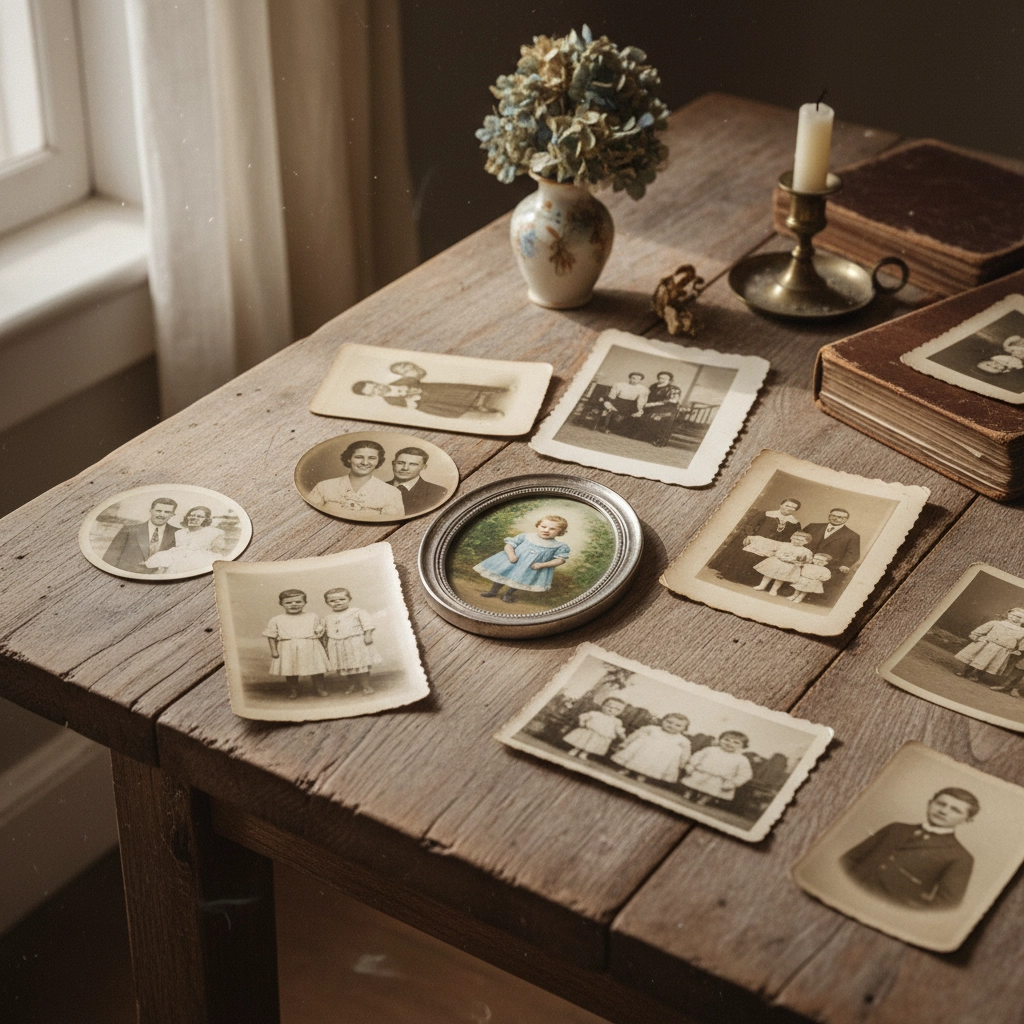Picture this: you're staring at a handwritten census record from 1851, squinting at what might be your great-great-grandmother's name, but the writing looks like it was done during an earthquake. Sound familiar? Or maybe you've got a stack of documents in French that could hold the key to your Acadian roots, but your high school French is about as useful as a chocolate teapot.
Well, here's some brilliant news – artificial intelligence has stepped into the genealogy world, and it's absolutely revolutionising how we research our family histories. As someone who's been wrestling with stubborn ancestors for years, I can tell you that AI isn't here to replace us genealogists (thank goodness!), but it's become our secret weapon for tackling those research mountains that once seemed impossible to climb.
What AI Actually Does in Genealogy Research
Let's cut through the tech jargon, shall we? At its heart, AI in genealogy works through something called Natural Language Processing (NLP) and machine learning. Think of NLP as a incredibly clever translator that can read, understand, and make sense of human language – even the scratchy handwriting of a Victorian-era parish clerk.

Machine learning is the real game-changer here. These algorithms analyse massive datasets of family history information, spotting patterns and connections that would take us humans months or even years to identify. It's like having a research assistant with a photographic memory who never needs a coffee break and can cross-reference millions of records in seconds.
The beauty of this technology lies in its ability to predict relationships between individuals and identify those elusive missing links in your family tree. Whether you're trying to connect DNA matches or decipher the relationship between two people mentioned in the same document, AI can analyse the data and suggest the most likely connections based on patterns it's learned from countless other family histories.
The Game-Changing Applications
Transcribing Those Impossible Records
Remember that earthquake-handwriting census record I mentioned? AI handwriting recognition software has become absolutely brilliant at converting these documents into searchable digital text. FamilySearch has been using this technology to index handwritten documents dating back to the 1400s – imagine trying to do that manually!
What used to take teams of volunteers months to transcribe can now be processed in days. Of course, human verification is still essential (we're not quite at the "trust the robots completely" stage yet), but AI gives us a tremendous head start.
Breaking Down Language Barriers
Here's where things get really exciting for those of us with international roots. AI translation tools like Google Translate have become sophisticated enough to tackle historical documents in foreign languages with remarkable accuracy. Whilst you'll still want professional verification for critical details, these tools can quickly tell you whether that German church record or French marriage certificate is worth pursuing.
I've seen genealogists use AI translation to identify relevant documents in minutes rather than hiring expensive translation services upfront. It's particularly valuable when you're dealing with large collections of foreign-language documents and need to prioritise which ones to focus on.
Bringing Photos to Life
The visual side of AI has absolutely captivated the genealogy community. MyHeritage's AI tools can colourise black-and-white photographs, enhance image quality, and even create animated videos of your ancestors. It might sound a bit gimmicky, but there's something genuinely moving about seeing your great-grandmother's photograph come to life, even if it's just a gentle animation.

AI-powered image recognition can also organise and identify faces in photograph collections, making it easier to track individuals across multiple images. This is particularly helpful when you've inherited boxes of unlabelled family photos – we've all been there!
Supercharged Record Matching
This is where AI truly shines in practical genealogy work. Platforms like Ancestry use sophisticated algorithms to analyse records and suggest potential matches, helping you discover connections you might have missed. These systems can spot similarities in names, dates, and locations across multiple databases, essentially doing the legwork of cross-referencing millions of records.
The AI doesn't just match exact names – it understands variations, common misspellings, and even cultural naming patterns. It might connect "William" in one record with "Bill" in another, or recognise that "O'Brien" and "Brien" likely refer to the same family line.
Tools You Can Start Using Today
Platform-Specific AI Features
Ancestry has integrated AI throughout their platform, from the familiar Ancestry Hints system to more advanced features like handwriting recognition for transcribing documents. Their AI also powers the Newspaper.com Obituary Index, where algorithms identify obituary articles by analysing linguistic patterns rather than requiring manual review of every page.
MyHeritage focuses heavily on photograph analysis and enhancement. Their AI Time Machine feature has become wildly popular, generating animated videos of historical photographs that create genuinely engaging experiences for family members who might not typically show interest in genealogy.
FamilySearch continues advancing their AI capabilities for indexing handwritten documents. Their approach combines AI transcription with volunteer verification – a smart balance that maintains accuracy whilst dramatically speeding up the process.
General AI Tools for Genealogists
Beyond the genealogy-specific platforms, general-purpose AI tools have become invaluable research assistants. ChatGPT, Claude, Gemini, and Perplexity can help you brainstorm research strategies, analyse historical context, organise research notes, and even draft biographical narratives about your ancestors.

These tools excel at helping you formulate better research questions. Instead of wondering "Where should I look next?", you can ask the AI to suggest specific record types, repositories, or research strategies based on your current findings. They're also brilliant at synthesising information from multiple sources and transforming dry genealogical data into compelling family stories.
The Crucial Caveats (Listen Up, This Is Important!)
Now, before you start trusting AI with your family's entire history, let's have a serious chat about limitations. AI is a phenomenal research accelerator, but it's not a replacement for human judgement, and it certainly isn't infallible.
Always Verify Everything
This cannot be overstated: never accept AI-generated information without independent verification. All translations, record matches, and historical contexts need validation from qualified sources before being incorporated into your family tree. I've seen too many family trees corrupted by unverified AI suggestions that seemed plausible but were completely wrong.
AI Amplifies Existing Biases
AI systems learn from existing data, which means they can perpetuate historical biases present in genealogical records. They might be less accurate with non-European names, struggle with records from underrepresented communities, or make assumptions based on incomplete historical data.
Know Your Role as the Expert
Remember, you're the genealogist here – AI is your research assistant, not your replacement. The technology handles rapid processing and pattern recognition brilliantly, but it cannot replace the interpretive expertise that comes with understanding historical contexts, evaluating source quality, and making nuanced judgements about evidence.

Making AI Work for Your Research
Start small and build your confidence with AI tools gradually. Begin with simple tasks like translating a single document or using AI to brainstorm research strategies for a brick wall ancestor. As you become more comfortable with what AI can and cannot do, you'll develop a better sense of where it fits into your research workflow.
Keep detailed records of which AI tools you've used and what they've suggested. This documentation helps you track your research process and makes it easier to verify information later. It's also crucial for maintaining the scholarly standards that good genealogy requires.
Most importantly, approach AI as a collaborative partner rather than an authority. Use it to accelerate the mechanical aspects of research whilst maintaining your role as the critical thinker who evaluates evidence and draws conclusions.
The integration of AI into genealogy represents one of the most exciting developments in family history research in decades. These tools are democratising access to records, breaking down language barriers, and helping us process information at unprecedented speeds. Whether you're just starting your genealogy journey or you're a seasoned researcher hitting stubborn brick walls, AI offers new pathways to discover your family's story.
The key is embracing these tools whilst maintaining the rigorous standards that make genealogy a respected field of study. AI won't solve all your genealogical mysteries overnight, but it will certainly make the journey more efficient and, in many cases, more enjoyable. After all, every moment AI saves you on transcription or translation is another moment you can spend uncovering the human stories that make family history so compelling.
